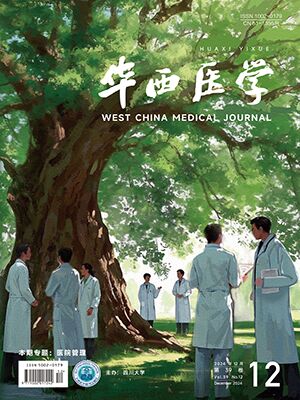| 1. |
Malta DC, Andrade S, Oliveira TP, et al. Probability of premature death for chronic non-communicable diseases, Brazil and Regions, projections to 2025. Rev Bras Epidemiol, 2019, 22: e190030.
|
| 2. |
de Gaetano M, McEvoy C, Andrews D, et al. Specialized pro-resolving lipid mediators: modulation of diabetes-associated cardio-, reno-, and retino-vascular complications. Front Pharmacol, 2018, 19(9): 1488.
|
| 3. |
许樟荣. 2017年糖尿病足病防治进展. 中华糖尿病杂志, 2018, 10(1): 68-71.
|
| 4. |
王婧薷, 杨荣华, 陈晓东. 自体富血小板血浆在糖尿病足治疗中的应用进展. 中华损伤与修复杂志(电子版), 2018, 13(2): 139-141.
|
| 5. |
Mishra SC, Chhatbar KC, Kashikar A, et al. Diabetic foot. BMJ, 2017, 16(359): 5064.
|
| 6. |
葛均波, 徐永健. 内科学. 8版. 北京: 人民卫生出版社, 2013: 175.
|
| 7. |
American Diabetes Association. American Diabetes Association Standards of Medical Care in Diabetes—2019. Diabetes Care, 2019, 42: S1-S186.
|
| 8. |
唐黎之, 童南伟. 美国糖尿病学会2018年版糖尿病医学诊疗标准更新内容解读. 华西医学, 2018, 33(5): 513-519.
|
| 9. |
Bakker K, Apelqvist J, Schaper NC. Practical guidelines on the management and prevention of the diabetic foot 2011. Diabetes Metab Res Rev, 2012, 28(Suppl 1): 225-231.
|
| 10. |
Wagner FW Jr. The dysvascular foot: a system of diagnosis and treatment. Foot Ankle, 198l, 2(2): 64-122.
|
| 11. |
Wang T, Li X, Fan LH, et al. Negative pressure wound therapy promoted wound healing by suppressing inflammation via down-regulating MAPK-JNK signaling pathway in diabetic foot patients. Diabetes Res Clin Pract, 2019, 150(15): 81-89.
|
| 12. |
Atic R, Deveci E. Endothelin 1, NF-kappa B, and ADAM-15 expression in diabetic foot wounds. Bratisl Lek Listy, 2019, 120(1): 58-64.
|
| 13. |
陈静, 程庆丰, 陈悦, 等. 糖尿病足患者截肢及生存预后影响因素分析. 中国糖尿病杂志, 2018, 26(2): 123-127.
|
| 14. |
吕晓玉, 王中京. 糖尿病足创面内miR-29b表达水平与氧化应激介质、炎症细胞因子的相关性研究. 海南医学院学报, 2019, 25(4): 302-304, 309.
|
| 15. |
马朋朋, 董聪慧, 李伟, 等. 前列地尔注射液联合二甲双胍片治疗糖尿病足周围神经病变的临床研究. 中国临床药理学杂志, 2018, 34(16): 1942-1944, 1948.
|
| 16. |
吴炎, 张睿, 黄冰, 等. 糖尿病足患者血浆脂蛋白相关磷脂酶A2、D-二聚体和纤维蛋白原水平变化及临床意义. 检验医学与临床, 2018, 15(14): 2175-2177.
|
| 17. |
万瑛. 糖尿病足患者血清IL-18和IL-6浓度监测的临床意义. 江苏大学学报(医学版), 2018, 28(5): 447-449.
|
| 18. |
钱超, 余建华, 谷费菲, 等. 糖尿病足患者脂蛋白相关磷脂酶A2、D-二聚体及纤维蛋白原水平分析. 国际检验医学杂志, 2015, 10(22): 3303-3304.
|
| 19. |
Mohammad NA, Khresheh RM. Evaluate the effect of education interventions in the prevention of diabetic foot ulcers through knowledge of the disease and self-care practices in Saudi Arabia. Open Access Maced J Med Sci, 2018, 6(11): 2206-2213.
|
| 20. |
王艳红, 岳宗相, 黄荣利, 等. 糖尿病足患者临床特征及危险因素分析. 华西医学, 2017, 32(8): 1199-1202.
|




